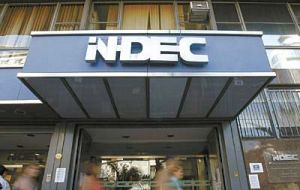MercoPress. South Atlantic News Agency
Kirchner inflation index for March 1%; Argentina's CPI 4.2%
 Indec headquarter in Bs Aires
Indec headquarter in Bs Aires Two Argentine provinces, which are out of the Kirchners' political influence, have reported monthly inflation almost four times the official percentage, according to the latest releases from the Statistics and Census Office in Buenos Aires and its branches in Santa Fe and San Luis.
According to Indec headquarter in Buenos Aires the Consumer Price Index, CPI, for March at national level in Argentina averaged 1.6%, although in Buenos Aires City and Buenos Aires province the CPI was lower, 1% and 1.6% respectively. However in Santa Fe and San Luis the Indec offices reported provincial CPI of 4.2% and 4.1% respectively, which is almost four times the national average published by Indec Buenos Aires; an office that has been purged several times of its best staff and replaced by "unconditional" personnel who "simply follow instructions", according to claims from the organization's union. The two Kirchner administrations have repeatedly intervened Indec to ensure inflation numbers are kept below two digits, thus helping, theoretically, to contain labor salary contracts and sovereign debt payments, much of it conditioned to domestic inflation and expansion of the economy. But the Indec rates manipulation has been so evident and coarse that it is no longer taken as a reference by the private sector or labor unions and even the IMF has suggested changing the system to make it more reliable. In absence of such basic information the private sector appeals as reference to the CPI of these two provinces which are ruled by non Kirchners faithful. Santa Fe is Socialist and Governor Hermes Binner simply instructed the local Indec branch to act with the most transparency possible. San Luis is ruled by dissidents from the ruling catch all Justicialista party (that is now under the aegis of the Kirchners) and the local Indec office is entirely professional. "March's CPI can be basically explained by the hike in food prices and to be honest the 4.2% even surprised us. We simply work with the national methodology without interfering or altering any numbers or products from the listing", said Jorge Moore head of the Santa Fe Indec office. In practical terms this means that inflation in the first quarter of 2008 in Santa Fe reached 7.1% compared to the "official" Buenos Aires index of 2.5%. The provincial "dissident" Indec offices are more in line with private estimates of annual inflation in Argentina, in the range of 20 to 22%, but could become even higher as the government stubbornly insists with manipulated ratings and economic agents' expectations look for protection from possible higher percentages. Argentina's national average CPI takes into account the evolution of prices in seven provinces, Buenos Aires, Cordoba, Santa Fe, Tucumán, Catamarca, Mendoza and San Luis plus the capital Buenos Aires City. Private analysts expect more surprises for April since of the seven provinces taken into account three are already out of the Indec Kirchner noose: Santa Fe, San Luis and Mendoza and next month Cordoba and Catamarca could follow. Cordoba's Governor Juan Schiaretti has had differences with President Cristina Fernandez de Kirchner and sided with the farmers during the recent strike. Catamarca governor Eduardo Brizuela del Moral, originally from the opposition, joined the Kirchners team for last October's election and now feels disenchanted with the current Kirchner policies towards his province. March CPI in Cordoba and Catamarca was 1.7% and 1.4%. Maybe when the April readings are released in May the local Indec offices from these two provinces could begin showing the full impact of inflation in Argentina (and disappointment with the Kirchners).




Top Comments
Disclaimer & comment rulesCommenting for this story is now closed.
If you have a Facebook account, become a fan and comment on our Facebook Page!